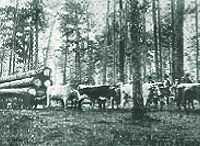Hattiesburg, in the Choctaw Indian lands of Mississippi, was founded in 1882 by Captain William H. Hardy, pioneer lumberman and civil engineer.
Early settlers of Scottish, Irish, and English extraction from Georgia and the Carolinas, attracted
by the vast acreage of virgin pine timber lands, came into this rich and promising area at a time
when a move was being made to renew development for the South.
 Early settlers harvested virgin pines to fuel the local economy The City of Hattiesburg; was
incorporated in 1884 with a population of approximately 400. The
place has been known as Twin Forks and later as Gordonville. Captain Hardy gave it the third and
final name of Hattiesburg, in honor of his wife whose name was Hattie.
Early settlers harvested virgin pines to fuel the local economy The City of Hattiesburg; was
incorporated in 1884 with a population of approximately 400. The
place has been known as Twin Forks and later as Gordonville. Captain Hardy gave it the third and
final name of Hattiesburg, in honor of his wife whose name was Hattie.
In 1884, the railroad [the New Orleans and Northeastern], which is now
a part of the Southern Railway System,
[which is part of the Norfolk Southern Railway System] was built from Meridian through
Hattiesburg to New Orleans. The commercial value of the great virgin pine stands was quickly
recognized and, for a time, timberland was available for as little as 50 cents to $1.50 an acre.
Mills sprang up; naval store plants came on the heels of the timber industry; and turpentine stills
were as numerous as sawmills.
The completion of the Gulf and Ship Island Railroad
through Hattiesburg from Gulfport to
Jackson, now part of the Illinois Central System, ushered in the real lumber boom in 1897. Though
it was twenty years in the building, the railroad more than fulfilled its promise. It gave the
state a deep-water harbor, more than doubled the population of towns along its route, built the
City of Gulfport, and made Hattiesburg a railroad center.
The introduction of rail travel offered many opportunities to Hattiesburg In 1908, Forrest
County was formed from a portion of Perry County, and Hattiesburg became the county seat. By 1915,
large areas of timber were cut, and a number of the large mills began to dismantle their plants.
But the 1914-1919 war period, with its growing demands and higher prices, presented industry with
an artificial stimulus.
many opportunities to Hattiesburg In 1908, Forrest
County was formed from a portion of Perry County, and Hattiesburg became the county seat. By 1915,
large areas of timber were cut, and a number of the large mills began to dismantle their plants.
But the 1914-1919 war period, with its growing demands and higher prices, presented industry with
an artificial stimulus.
After World War I, Hattiesburg found that a new way of life was necessary. The people of the
region were able to adjust themselves and proved willing to experiment in new ways of making a
living. Some of the experiments were as new to the world as to Mississippi, such as the tung oil
industry, which was brought from the Orient. Many experiments were related to the once-great lumber
and sawmill business.
The landowner today considers reforestation not as a long-term investment but as the basis of a
cash crop. Among new industrial plants are those producing turpentine, paint oils, chemicals, metal
products, apparel, food products, brick, concrete products, building materials, oil refining,
household appliances, small engines, paper making equipment, and many other items.

